A musical comes together, finds its audience, flourishes and closes. With luck, it may be revived or reconceived in some way. More likely, the show is forgotten, recalled only by an odd lot of buffs and scholars. Despite its strengths, despite its popularity, it winds up being relegated to the footnotes of theater history.
One work that ought to remain in the spotlight is “Shuffle Along.” So argues Caseen Gaines in “Footnotes: The Black Artists Who Rewrote the Rules of the Great White Way.” Premiering in 1921, the musical comedy “Shuffle Along” was the first successful all-black show to hit the Broadway stage in more than 10 years. Mr. Gaines’s absorbing book celebrates the show’s creators—Flournoy Miller, Aubrey Lyles, Eubie Blake and Noble Sissle—and illuminates the significance of their achievement.
“Shuffle Along” grew out of a vaudeville act featuring Miller and Lyles. The two met in 1903 at Fisk University in Nashville, Tenn. Miller was studying to become a minister, but his true calling was the stage. Lyles was studying medicine. As their friendship blossomed, they discovered that they had the gift of making their classmates laugh. There was something funny even in the sight of them together, with Miller standing nearly a foot taller than Lyles, and in the sound of them—Miller’s voice, writes Mr. Gaines, was “measured and gentle,” but Lyles’s “squawked.” They worked up a routine, performed on campus and dreamed of stardom. In 1905 they moved to Chicago, where Miller began writing the show “The Mayor of Dixie,” which would become the basis of “Shuffle Along.”
The music of “Shuffle Along” was the work of Blake and Sissle, the composer and lyricist. The two met in 1915 in Baltimore when Sissle joined Joe Porter’s Famous Dixie Serenaders as a singer. Blake was the band’s pianist. Drawn to music from an early age, Blake was enchanted by ragtime, the exuberant and off-kilter style associated most closely with Scott Joplin. In his teens, he sneaked out at night to play piano in a “sporting house”—a bordello—much to the consternation of his God-fearing mother. Sissle, whose father was a minister and mother a teacher, “grew into himself at church,” writes Mr. Gaines. Blessed with a fine voice, he had the instincts of a master showman. After high school, he enrolled first at DePauw and then Butler University, but the lure of music proved irresistible: He left school, led an orchestra in Indianapolis, and then headed east to join the Serenaders.
